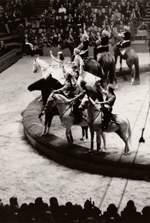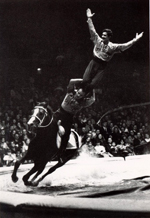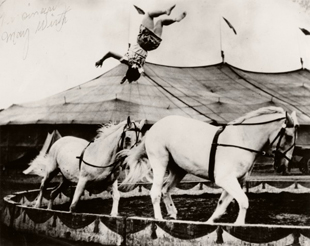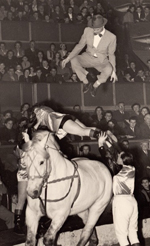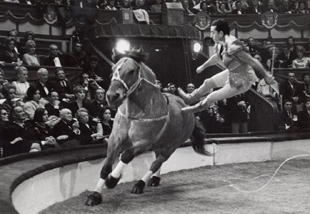by Pascal Jacob
The notion of equestrian acrobatics, underpinned by that of the exploit, combines the pure talent of the rider with an acrobatic sequence that unfurls to the rhythm of a repertoire of postures and jumps. It is in fact an assemblage of performances, which are often linked to a geographical region. The jockey, for example, was explicitly influenced by the taste for horse racing and developed in the British Isles, while Cossack and Cherkessk acrobatics bloomed in Eastern Europe, and the Far West nourished the fantasies of several generations by inspiring cowboys-and-Indians style acrobatics, a pale imitation of the living frescoes conceived by Buffalo Bill in his open arena from 1882 to 1912.
The art of war was full of surprising twists and turns, of which the horse is probably one of the most surprising, as its involvement in regular engagements since ancient times has been decisive. A fast mount provided its rider with mobility and strength, but was also positioned as a heavy, stable, and protective mobile fortress when harnessed for combat. This defensive variation was also illustrated when the horse was transformed into a mobile wall, a technique used by horsemen in a branch of warfare that spread form the plains Indians to the Mongols, as well as the Cossacks and the Cherkessk. The cleverest riders would slide under the stomach of their galloping mount, clinging on with their legs to hide themselves from enemy eyes and deliver arrows or bullets when they were least expected. This battlefield vocabulary was transposed to the ring to encourage the development of a whole area of equestrian acrobatics.
Mstislav Zapachny, a Russian rider and animal trainer evoked the notion of acro-riding to describe the lifts, columns and somersaults on horseback and also to define a second branch of forms and figures that constituted the repertoire of a discipline that was both classical and modern. Standing up on a galloping horse, like Philip Astley in 1768, or Irbek Kantemirov in the 1930s, was in fact similar to an acrobatics exercise.
Development
The logic of one-upmanship and of surpassing all limits, which ahs identified the circus since its origins, would find particularly fertile ground for development in equestrian acrobatics. Incorporating acrobatics was a decisive step forward, strengthening the dynamic dimension of the exercises and culminating with Frediani's column of three, a feat that has remained unrivalled, but which lies firmly in the spectacular register in place in the early 20th century. IN 1825, the rider Jacques Gautier famously opened the performance "ball" by turning a somersault on the back of his horse, which was equipped with a wooden saddle that was the precursor of James Morton's panneau invented in 1849.
A century later, the American Orin Davenport created the horse-to-horse somersault. This extraordinary feat was base don perfect mastery of the synchronised pace of the animals, regulated by a rigorous and precise ringmaster. The French rider Chotachen Courtault complicated the exercise by adding a pirouette, and the Italian Lucio Cristiani performed it by leaping from one horse to land on a third! The riders were not to be outdone by Miss Linda Jeal in 1880 and May Wirth and Dorothy Herbert in the 1930s, who were often compared to the figure of Mazeppa, made popular by the actress Addah Menken.
At the end of the 19th century, the big equestrian companies began to appear, often formed from a powerful family core enriched by exceptional characters capable of completing the company repertoire with an out of the ordinary exercise. The Lécussons, the Casis, the Sobolewskis, the Hannefords, the Cristianis, the Zapashnys, the Carolis, the Picards and the Richters made a similar acrobatic register popular form one side of the world to the other, by performing acts that were constructed as constant progress was made.
The first part generally provided the audience with an exhaustive catalogue of the acrobats' skills. This was the time for standing jumps and somersaults, which formed a spectacular prelude to the pyramids executed by the entire "family."
In 1942, the Cristianis ended their act with the entrance of an enormous horse, on which the company's male and female acrobats literally flew. The apparent ease with which they accomplished sequences of individual or group figures systematically incited applause from the circus employees, the sole spectators at morning rehearsals.
Variations
Cossack dzhigitovka, cowboy-style acrobatics, the Epsom Jockey initiated by the English circus rider Billy Bell, or Richard-style acrobatics named for their creator: the references are multiple and borrow frequently from each other in the definition of their fundamental acrobatics. The analogy with the energy of the Far West horsemen is explicit, motivated by the success of Captain Cody's Wild West Show performed in Europe from 1889. More than a century later, the equestrian show Cavalia, directed by Erik Villeneuve, saw its second half open with an astonishing demonstration of cowboy acrobatics, developed in a line, with a run up outside the big top and several dozen metres of ground covered at breakneck speed. The cowboys' positions in the saddle evoked Richard-style acrobatics, a technique that has become obsolete in today's rings, which saw riders use the surcingle – a harness equipped with a pommel, as a support for performing jumps and planks. The technique was illustrated, mainly by Henri de Toulouse-Lautrec, in his album At the Circus. A voluntarily group practice, acrobatics can also give rise on occasion to a solo rider number: Dany Renz gave Robin Hood – better know for his archery than his horsemanship – a brilliant second life with exceptional style and elegance.
For more than forty seasons, the Grüss family, including Alexis, Patrick, Stephan, Firmin, Martine, Charles, Louis and Alexandre, maintained high standards in French acrobatics, using specific leg tension that propelled the riders and provided remarkably light jumps executed without cushions. Meanwhile Battuta, by Bartabas, paid a vibrant tribute to acrobatics through a show exclusively based on this demanding discipline, which always makes the most blasé of audiences tremble in their seats.




